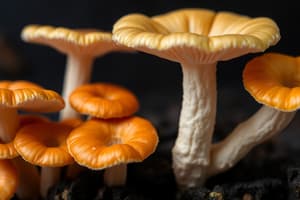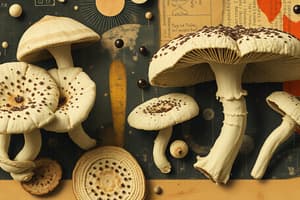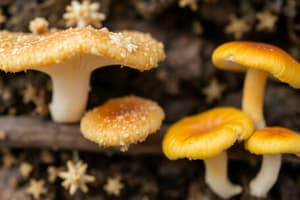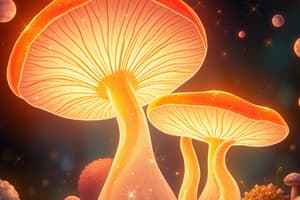Podcast
Questions and Answers
Which characteristic primarily differentiates yeast from molds?
Which characteristic primarily differentiates yeast from molds?
- Yeast grow as single cells, while molds grow as multiple tubular branches. (correct)
- Molds can grow in both aerobic and anaerobic conditions, but yeast can only grow in aerobic conditions.
- Yeast are multicellular, while molds are unicellular.
- Yeast reproduce only through spore formation.
In what environmental condition are molds typically found?
In what environmental condition are molds typically found?
- High-temperature, sterile environments.
- Areas with high concentrations of oxygen and low humidity.
- Damp, dark, or humid areas. (correct)
- Extremely dry and well-lit environments.
How do yeasts typically reproduce asexually?
How do yeasts typically reproduce asexually?
- Through spore production.
- Through the formation of true hyphae.
- Through binary fission or budding. (correct)
- Through the creation of colorful spores.
Under what conditions can yeast pose a significant health risk?
Under what conditions can yeast pose a significant health risk?
Which of the following statements best describes the hyphae of molds?
Which of the following statements best describes the hyphae of molds?
What is a key characteristic of yeast regarding its oxygen requirements?
What is a key characteristic of yeast regarding its oxygen requirements?
How would you describe the appearance of molds?
How would you describe the appearance of molds?
What distinguishes pseudohyphae from true hyphae in fungi?
What distinguishes pseudohyphae from true hyphae in fungi?
Flashcards
What are Fungi?
What are Fungi?
Eukaryotic microorganisms, including yeasts and molds.
Fungus relevant to dentistry
Fungus relevant to dentistry
Candida, exists in two structural forms: yeast and mold.
Form of Yeast
Form of Yeast
Grow as large single cells.
Cell type of Yeast
Cell type of Yeast
Signup and view all the flashcards
Habitat of Yeast
Habitat of Yeast
Signup and view all the flashcards
Appearance of Yeast?
Appearance of Yeast?
Signup and view all the flashcards
Form of Moulds
Form of Moulds
Signup and view all the flashcards
Cell type of Moulds
Cell type of Moulds
Signup and view all the flashcards
Study Notes
- The presentation discusses fungi and mould in the context of biomedical science
- By the end of the session, students should be able to differentiate yeast from mould and identify fungal commensal flora and their location
Features of Fungi
- Fungi are eukaryotic organisms
- The most important fungus relevant to dentistry is Candida
- Fungi come in two structural forms: yeast and mould
- Some fungi are dimorphic, meaning they can exist as both yeast and mould
Yeast Characteristics
- Grow as large single cells and are unicellular
- Commonly found on fruit, in the stomach of mammals, and in oral and vaginal areas
- Yeast appears white and thready, usually oval in shape
- Yeasts do not have true hyphae, instead forming multicellular structures called pseudo-hyphae
- Yeast is not a sporing species of fungi
- Yeasts are less colorful compared to moulds, appearing collectively yellow creamy
- Yeast can grow in both aerobic and anaerobic conditions
- Can cause infection in individuals with compromised immune systems
- Often have lateral projections, called daughter cells
- Reproduces asexually mostly, through budding
Mould Characteristics
- Grow as multiple tubular branches and are multicellular
- Typically found in damp, dark, or humid areas
- Appear fluffy and come in several shapes
- Have microscopic filaments called hyphae and are a sporing fungus
- Moulds are very colorful, maybe orange, green, black, brown, pink or purple
- Grow only in aerobic conditions
- Health risks usually consist of allergic reactions and respiratory problems
- Consist of multicellular threads called hyphae
- Hyphae contain cytoplasm and organelles
- Mycelium is a mass of hyphae that forms mould colonies
- Reproduce through spores, with a reproduction that is either be asexual or sexual
Fungal Commensal Flora
- Fungal commensal flora includes species such as Aspergillus, Candida, and Malassezia
- Different fungal species are found in various locations on/in the human body, including the oral cavity, nares, lungs, colon, vagina, skin (palm, antecubital fossa, plantar heel), and toe web space
Studying That Suits You
Use AI to generate personalized quizzes and flashcards to suit your learning preferences.




